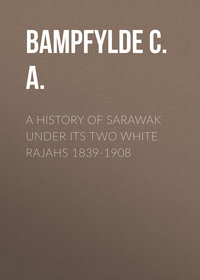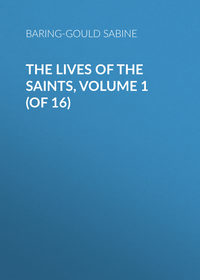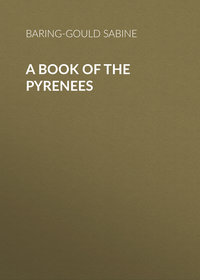 полная версия
полная версияA Book of The Riviera
“It was,” says Brantôme, “a common opinion at the time that there existed a secret engagement between Barbarossa and Doria to avoid fighting each other on decisive occasions, so as to prolong the war, which gave both of them employment, and furnished them with means of acquiring wealth.”
What seems to confirm this was the setting at liberty by Doria of the renegade corsair Dragut, who had been made prisoner, and who was a favourite of Barbarossa, and a scourge to the Christians.
In 1547 a conspiracy of the Fieschi almost cost Andrew Doria his life. His nephew was murdered by them, but at the same time Giovanni Luigi Fieschi was drowned. Grief and resentment provoked Andrew Doria to commit acts of atrocious cruelty.
Scarcely was this conspiracy crushed, before Giulio Cibo, brother-in-law of Giovanni Luigi Fieschi, formed another out of the remnant of the faction. This was discovered; Cibo had his head struck off, and all the rest of the Fieschi and those who held by them were banished. The brother of Giovanni Luigi fell into Doria’s hands, and was by his orders sewn up in a sack and thrown into the sea.
Andrew had been much worried by a pilot asking him for this and for that. Doria said, “If you speak again to me more than three words, I will have you hung.” “Pay or discharge,” said the pilot. Doria laughed, gave him his pay, and retained his services.
Andrew Doria met with a great reverse at the hands of that same Dragut whom he had released to please Barbarossa. In 1552 Dragut came on him when he was least awares, and put him to flight. Dragut pursued him, sank two of his vessels, captured seven of his fleet with seven hundred German soldiers, and their captain, Nicolas Madrucci.
Andrew died in his splendid palace near Genoa in 1560, at the age of 93, without leaving issue by his wife who was niece of Pope Innocent VIII.
Albenga, easily reached from Alassio, either by road or rail, is a most interesting but unhealthy town. It lies low where three rivers, uniting, empty into the sea, and the plain is made up of deposits brought down by them. Anciently the sea reached to its walls, and only withdrew in the tenth century. Albenga was the capital of the Ligurian Ingauni, and a great naval station. Thence sailed a fleet of thirty-two ships which fought the Romans in B.C. 20. It helped Hannibal with ships and men, and when Magone, brother of Hannibal, was wounded, he retired to Albenga to be cured.
Afterwards it became, but reluctantly, allied to Rome. In the times of Probus, A.D. 276-282, a native of Albenga, named Proculus, a man of extraordinary strength, set up to be emperor, but was speedily killed. Constantine, a grandee of the Court of Honorius, A.D. 395-423, fortified the town, and he it was who built the Ponte Longo, a Roman bridge now sunk to the spring of the arches, and deserted by the river, which has completely altered its course.
Albenga has a most interesting cathedral of the twelfth century that has been mutilated and altered internally into a rococo temple. The west front was partly removed in renaissance times and rebuilt, clumsily; but externally, the east end with its apses tells of the true antiquity of the church. Hard by is what is still more venerable: a baptistery, half buried in the soil, of the fifth (?) century. It is descended into by fourteen steps, so greatly has the soil risen since it was built. The building is octagonal, and had its windows filled with pierced slabs of stone; of these fillings in only two remain, one very rich, with carved interlaced work as well as with perforations. Within is a large font for immersion, as at Ventimiglia, and the vault is sustained by eight granite columns, probably taken from a Pagan temple. The altar is ancient, enriched with mosaic work representing the Agnus Dei surrounded by twelve doves.
At the east end of the cathedral is the Piazza dei Leoni, where are three rude stone lions, remains of a monument raised in 1288, but taken from an earlier Roman structure.
That which strikes the visitor especially, coming from France, are the towers of the nobles. “Its thirteen mediæval towers,” says Hare, “remind the Italian traveller of S. Gimignano, rising out of the plain like a number of tall ninepins set close together.” I do not think there are thirteen; certainly not that number of lofty towers; but the earthquake of 1887 damaged, or threw down, several.
The finest are the Torre Balestrino, the cathedral tower, and the Torre del Comune. Five of the old gates remain. The church of S. Maria in Fontibus, in Genoese Gothic, striped black and white marble, takes its name from a spring that rises under the altar, and was supposed to possess miraculous powers for the healing of lepers.
A beautiful drive from Albenga up the valley leads to Garlenda, where are paintings by Domenichino, a S. Maurus, a Martyrdom of S. Erasmus, by Poussin; and a Nativity of Our Lady by Guercino. At the time of the French Revolution, when the troops were pouring over the frontier into Italy, the parishioners of Garlenda, fearful of being robbed of these artistic treasures, removed and hid them.
The road to Garlenda passes through orchards of peaches and fields of narcissus.
“The valley is radiantly beautiful in spring. Overhead are tall peach trees with their luxuriance of pink blossom. Beneath these the vines cling in Bacchanalian festoons, leaping from tree to tree, and below all large melons, young corn, and bright green flax, waving here and there into sheets of blue flower, form the carpet of Nature. Sometimes gaily-painted towers and ancient palazzi, with carved armorial gateways and arched porticoes, break in upon the solitude of the valley.” – Hare.
CHAPTER XIX
SAVONA
The city and port – Pope Sixtus IV. – The Della Rovere family – Nepotism – Assassination of Giuliano di Medici – Methods of filling the treasury – Sixtus and the Spirituals – Julius II. – A fighting pope: his portrait by Raphael – Pius VII. at Savona: his removal from Rome – Death of Princess Borgia – Bishop Grossulano – The Margravate of Savona – The Sanctuario – Crowned images – Jacques de Voragine – The Albizzola Palace: and Gardens – Mme. de Genlis and travelling on Corniche Road – Ruined palaces of LiguriaSAVONA, with its port, its towers, its engirdling mountains, and its wide-stretching orange and lemon orchards, is a very charming town.
The port, with its picturesque tower, engages the eye at once. The cathedral, built in 1604, is in the uninteresting style of that period. It contains some good pictures by Brea, 1495, and Aurelio Robertelli, 1449; and the tomb of the parents of Pope Sixtus IV. who was a native of Celle, near Savona. His father was a poor boat or fisherman called della Rovere; but it was the whim of Francesco della Rovere, when he became Pope under the title of Sixtus IV., to be thought a scion of the ancient house of the same name at Turin. A false pedigree was forged, and he purchased the complaisance of the Turin family, and silenced their jibes, by giving them two cardinal’s hats. He assumed their arms – a golden oak tree on an azure ground – which figures on the tomb at Savona, and which Michael Angelo painted on the roof of the Sistine Chapel, in compliment to Pope Sixtus and to his nephew Julius.
Francis de la Rovere was born in 1414, and entered the Franciscan order, became provincial of Liguria, and finally general of the order. He was elevated to be Cardinal by the advice of Bessarion, who had conceived a high notion of his learning and abilities. He became Pope in 1471 and occupied the papal chair till 1484, and was perhaps the second wickedest pontiff seated on that throne, coming only a short way after Alexander VI.
“He began his career with a lie,” says Mr. Addington Symonds, “for though he succeeded to the avaricious Paul, who had spent his time in amassing money which he did not use, he declared that he had only found 5,000 florins in the Papal treasury. This assertion was proved false by the prodigality with which he lavished wealth immediately upon his nephews. It is difficult even to hint at the horrible suspicions which were cast upon the birth of two of the Pope’s nephews. Yet the private life of Sixtus rendered the most monstrous stories plausible. We may, however, dwell on the principal features of his nepotism; for Sixtus was the first pontiff who deliberately organised a system for pillaging the Church in order to exalt his own family to principalities. The names of the Pope’s nephews were Leonardo, Giuliano, and Giovanni della Rovere, the three sons of his brother Raffiello; Pietro and Girolamo Riario, the two sons of his sister Jolanda; and Girolamo, the son of another sister, married to Giovanno Basso. With the notable exception of Giuliano della Rovere, these young men had no claim to distinction beyond good looks and a certain martial spirit which ill suited with the ecclesiastical dignities thrust upon some of them. Leonardo was made Prefect of Rome and married to a natural daughter of King Ferdinand of Naples. Giuliano received a cardinal’s hat, and after a tempestuous warfare with the intervening Popes, ascended the holy chair as Julius II. Girolamo Basso was created Cardinal of San Cristogono.”
But the favourite nephew of all was Pedro Riario, whom his uncle loaded with ecclesiastical benefices, though aged only five-and-twenty. Scandal asserted, and Muratori believed it, that this Pietro was really the son of the Pope. When scarce out of the hobbledehoy age, he was made Cardinal Patriarch of Constantinople and Archbishop of Florence. His annual income was 60,000 gold florins, in our money about £100,000; and yet when he died, broken down by his debaucheries, in 1474, three years after he had been made Cardinal Archbishop, he was deep in debt.
“He had no virtues, no abilities, nothing but his beauty, the scandalous affection of the Pope, and the extravagant profligacy of his own life, to recommend him to the notice of posterity. All Italy during two years rang with the noise of his debaucheries. When Leonora of Aragon passed through Rome, on her way to wed the Marquess of Ferrara, this fop of a Patriarch erected a pavilion in the Piazza di’ Sante Apostole for her entertainment. The air of the banquet hall was cooled with pure water; on a column in the centre stood a naked gilded boy, who poured forth water from an urn. The servants were arrayed in silk, and the seneschal changed his dress of richest stuffs and jewels four times in the course of the banquet. Nymphs and centaurs, singers and buffoons, drank choice wines from golden goblets… Happily for the Church and for Italy, he expired at Rome in January, 1474, after parading his impudent debaucheries through Milan and Venice, as the Pope’s Legate.”
Another nephew was Girolamo Riario, who married a natural daughter of Galeazzo Sforza. For him the Pope bought the town of Imola with Church money. He had created him Count of Bosco in 1472. As Imola did not content his ambition, his uncle gave him Forli, and elevated this boatboy to a dukedom. The young ruffian found that the Medici family stood in the way of extending his power over Florence, and he formed a plot for their destruction. In the conspiracy were involved Francis di Pazzi, head of the bank of that name in Rome, and Salviati, a Florentine, Archbishop of Pisa, whose elevation had been opposed by the Medici. The plot was atrocious; it was no less than to assassinate Giuliano and Lorenzo di Medici in the duomo at Florence on Easter Day at high mass. It had the hearty concurrence of him who held the keys of heaven and hell. Into the wicked confederacy was taken a Captain Montesecco, an intimate friend of Girolamo Riario, the Pope’s nephew, and Bandini, a hired murderer. It was arranged among them that Montesecco was to poignard Giuliano, and Bandini was to stab Lorenzo; and the signal for the deed was to be the Elevation of the Host. On the Sunday appointed, 1478, the assassin Montesecco embraced the two Medici as they entered the church and assured himself by his touch that they were unprotected with coats of chain-mail, such as they usually wore under their silken habits. But at the last moment this captain, cut-throat though he was, felt hesitation at committing the deed in the sacred building and at such a solemn moment, and communicated his scruples to Girolamo Riario; and the latter had hastily to open his scheme to a couple of priests and induce them to undertake the murder. As a chronicler of the time says: “Another man was found, who, being a priest, was more accustomed to the place and therefore less scrupulous about its sanctity.” The second priest was to take the place of Bandini should he entertain qualms.
But this change of persons spoiled all. The priest, though more irreligious, was less expert. Giuliano was indeed stabbed to death by Bandini di Pazzi, at the moment of the Elevation of the Host, but Lorenzo escaped with a flesh wound from the inexperienced hand of the priest, and fled into the sacristy. The congregation, the whole populace of Florence, rose as a man, and pursued the murderers. The Archbishop Salviati di Pazzi, and some of the others, were seized and hung from the windows of the Palazzo Pubblico, the same day; and the eighteen-year-old Cardinal Raphael Riario was flung into prison.
Sixtus was furious at the failure of the plot, and demanded the liberation of his great nephew, the boy-Cardinal, and at the same time the expulsion of the Medici from Florence. As the citizens refused to do this, he excommunicated Lorenzo di Medici, and all the heads of the Republic, and placed Florence under an interdict. After a few days the boy was released; but that was as far as the Florentines would go. Accordingly the Pope, his nephew Riario, and the King of Naples, who had entered into league with the Pope, raised armies to attack Florence, and a savage war of revenge raged for years. It was not till 1481 that a descent of the Turks on Otranto made Sixtus tremble for his own safety, and forced him to make peace with Florence.
After the death of Pietro, Sixtus took his nephew, Giovanni della Rovere, into the favour that Pietro had enjoyed. He married him to Giovanna, daughter of the Duke of Urbino, and created him Duke of Sinigaglia. This fellow founded the second dynasty of the Dukes of Urbino.
“The plebeian violence of the Della Rovere temper,” says Mr. Addington Symonds, “reached a climax in Giovanni’s son, the Duke Francesco Maria, who murdered his sister’s lover with his own hands, when a youth of sixteen, and stabbed the Papal Legate to death in the streets of Bologna, when at the age of twenty, and knocked Guicciardini, the historian, down with a blow of his fist during a council of war in 1526.
“Christendom beheld in Sixtus the spectacle of a Pope who trafficked in the bodies of his subjects, and the holy things of God, to squander basely-gotten gold upon abandoned minions. The peace of Italy was destroyed by desolating wars in the advancement of the same worthless favourites. Sixtus destroyed to annex Ferrara to the dominions of Girolamo Riario. Nothing stood in his way but the House of Este, firmly planted for centuries and connected by marriage or alliance with the chief families of Italy. The Pope, whose lust for blood and broils were equalled only by his avarice and his libertinism, rushed with wild delight into a project which involved the discord of the whole peninsula. He made treaties with Venice and unmade them, stirred up all the passions of the despots and set them together by the ears, called the Swiss mercenaries into Lombardy, and when, finally, tired of fighting for his nephew, the Italian powers concluded the peace of Bagnolo, he died of rage in 1484. The Pope did actually die of disappointed fury, because peace had been restored to the country he had mangled for the sake of a favourite nephew.”
This Pope seemed unable to exist without some cringing favourite about his person. In 1463 he made his valet, a lad of no character and parts, of base birth, with nothing but his good looks and obsequiousness to speak for him – Cardinal and Bishop of Parma, when his age was only twenty.
Sixtus was always impecunious. To replenish his treasury he had two resources. One was the public sale of places about the Court, and of benefices and of ecclesiastical privileges. “Our churches, priests, altars, sacred rites, our prayers, even heaven and our God, are all purchasable,” is the exclamation of Baptista Mantuanus, a scholar of the period. His second expedient was the monopoly of corn throughout the Papal States. Fictitious dearths were created; the value of wheat was raised to famine prices, and good grain was sold out of the States of the Church and bad grain was imported, that the Pope might pocket the profits of the transaction. Sixtus forced his subjects to buy at his stores, and regarded their sufferings, and the disease bred of famine, with indifferent eye.
But, bad as he was, Sixtus did some good things. He laid the basis of the great Vatican library, built a bridge over the Tiber, and widened some of the streets.
To him is due the introduction into the calendar of the Feasts of the Conception of the Blessed Virgin, also of the Presentation in the Temple, and of Ste. Anne, all three of which find their place in the Anglican calendar; also of S. Joseph.
Sixtus happily put an end to the cruel persecution of the “Spirituals,” a branch of the Franciscan Order which advocated absolute poverty, and adherence to the original mandates of the founder. Their prophet and theologian had been d’Oliva. Pope John XXII. had pronounced the writings of d’Oliva heretical, and had handed over the “Spirituals” to the Inquisition, to be dealt with as heretics. Between 1316 and 1352 as many as 114 of them were burnt at the stake; but Sixtus IV. reversed the judgment of John XXII. and declared this teaching of Oliva to be orthodox; so that those who had been burnt in accordance with the judgment of one Pope, were martyrs for the truth according to the decision of another.
Sixtus died in 1484.
Stephanus Infessura, a contemporary diarist, writes on his death: —
“Sixtus died, on which most happy day God showed His power on earth, in that He liberated His Christian people from the hand of such an impious and iniquitous ruler, in whom was no fear of God, no love for the rule of Christian people, no charity, no tenderness, nothing but vile lusts, avarice, pride, and vain glory.”
He goes on with a catalogue of his crimes too horrible to be quoted.
So impressed was the College of Cardinals, on the death of Sixtus IV., with the injury done to the Church by the nepotism of the deceased Pope, by his alienation of Church fiefs to his kinsmen and favourites, that on the election of his successor, Innocent VIII., they made him swear on every relic and by everything that is held most sacred in Christendom, that he would not continue the same abuses. He took the required oath, and no sooner was he enthroned than he absolved himself from the oaths he had taken.
The same farce was enacted with Julius II. in 1503. It really seemed like a Nemesis, that the Popes, who, since the time of Gregory VII., had shown a rare ingenuity in inventing oaths by means of which to entangle men’s consciences and bring everything under their power, now themselves took oaths, which they as regularly broke. Indeed, it became obvious that no solemn oath taken by a Pope was worth the breath that uttered it, as he could at once absolve himself from observing it; and it is a riddle how the cardinals should have persisted in exacting capitulations from the Popes, when they must have known that they would break their plighted word as soon as ever they assumed the tiara. Julius II. pushed on the fortunes of his family, which had been already aggrandised by Sixtus IV. This done, he could devote himself, undisturbed by the importunities of his kindred, to the gratification of that innate love for war and broil which was the ruling passion of his life.
He was the fighting Pope, stern, resolute, indomitable. The whippings he had received from his father had steeled his spirit instead of breaking it. His portrait by Raphael admirably expresses the character of this second Della Rovere Pope. The hard, cold eye, the set frown, the determined mouth, about which a smile never quivered, and the flowing white beard, are eminently characteristic of the man. There is not in the face a trace of the ecclesiastic, not an indication of his having led a spiritual life. But for the habit, he might have been a doge or a military leader.
Ranke thus describes him: —
“Old as Julius was, worn by the vicissitudes of good and evil fortune experienced through a long life, by the fatigues of war and exile, and, above all, by the consequences of intemperance and profligacy, he yet did not know what fear or irresolution meant. In the extremity of age, he still retained that great characteristic of manhood, an indomitable spirit. He felt little respect for princes, and believed himself capable of mastering them all. He took the field in person, and having stormed Mirandola, he pressed into the city across the frozen ditches and through the breach; the most disastrous reverses could not shake his purpose, but seemed rather to waken new resources in him. He was accordingly successful; not only were his own baronies rescued from the Venetians, but in the fierce contest that ensued he finally made himself master of Parma, Placentia, and even Reggio, thus laying the foundation of a power such as no Pope ever possessed before him.”
A shrewd, dissolute, wicked man, he was superior to Sixtus in ability.
He had his mistresses, his luxury, his simony, and his cruelty, as Macchiavelli wrote of him.22 Savona has no cause to glory in those whom she sent to occupy the chair of S. Peter.
But the place is associated with another Pope, and that one of a different stamp altogether, the unfortunate Pius VII., relegated there in 1809, and obliged to remain there till 1814. Pius was a good, quiet man, without force of character. When Napoleon let him understand that the States of the Church were to be taken from him, Pius was in dire distress and perplexity. Acting on the advice of his confidential attendant, Cardinal Pacca, he launched an excommunication at Bonaparte, Miollis, governor of Rome, all the French, and all such Romans as participated in the annexation of the States to the kingdom. The document was nailed up to the doors of several of the Churches of Rome, —
“But nobody seemed a penny the worse.”
till an event occurred which startled the good people of the Eternal City.
There was a grand reception at the Chigi Palace, to which persons of all shades of politics were invited. A large company had already assembled, when the major-domo announced, “The Princess Borghese!” Now Prince Borghese had been an active partisan of Bonaparte and of the New Order. It was felt that the Prince and the Princess were both involved in the sentence of excommunication, and in former days no one would have dared to receive into his house those who had fallen under the ban of the Church. Presently the guests sat down to cards, and all went merrily until one o’clock struck, when the Princess fell back in her chair, and though she tried to speak, no intelligible sound issued from her lips. Helpless and speechless, she was conveyed to her own house, where she died three days later.
Then, as may be imagined, tongues wagged. It was confidently asserted that the Princess had been struck down by Providence. Her sudden death was represented as a just punishment for her sin in espousing the cause of the Pope’s enemies; and fanatics held her up as an awful example and a warning.
It was useless to hint that Providence had struck at very poor game – an already half-paralysed old woman – instead of smiting the real offenders. The Princess was in indifferent health at the time, had lost the use of her right arm through one stroke, and the recurrence was what might have been anticipated. No one would hear a word. She had reaped what others had sown.
Count Miollis now resolved on removing the Pope from the city. Although his excommunications and interdicts might safely be laughed at, yet his presence in Rome was a hindrance to general reform of abuses, and his person was a centre for every sort of cabal. The Pope was in the Quirinale, which was close barred. In the evening of June 5th the palace was surrounded by French soldiers, and pickets of cavalry patrolled the adjacent streets. Miollis authorised General Radet to use force if necessary, to enter the Quirinale and get possession of the Pope. Count Miollis stationed himself in a summer-house in the Colonna gardens, whence he could issue directions. Large numbers of the Italian and Roman nobles and people of the middle-class assembled to see what would take place.









